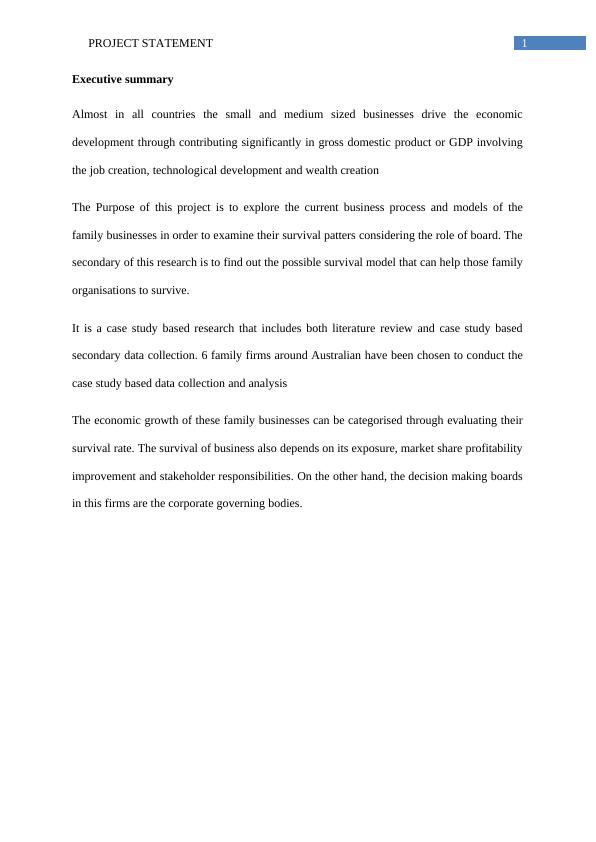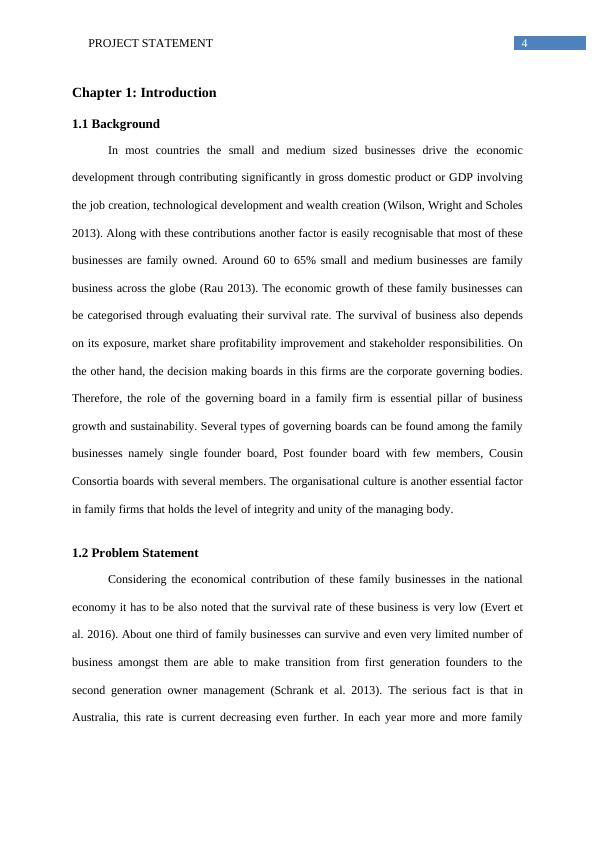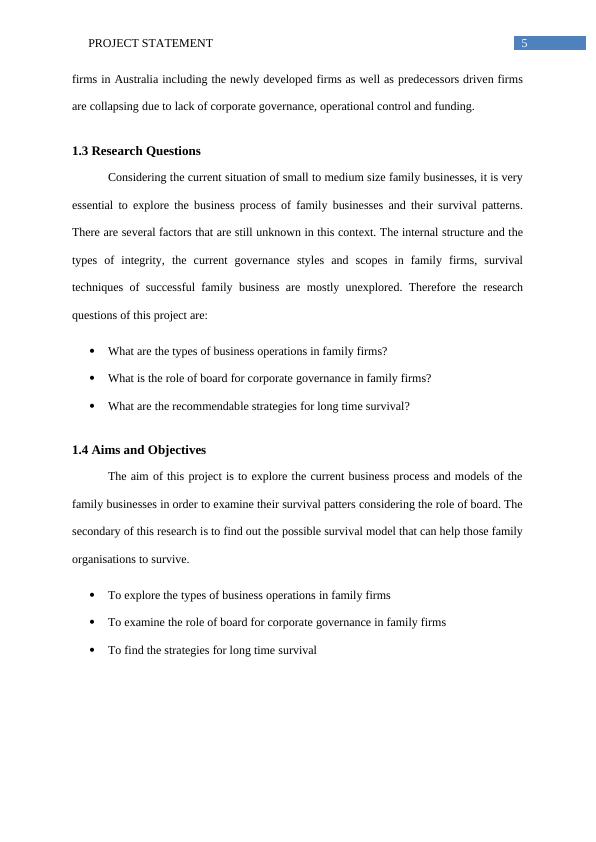Role of Boards in Survival Patterns of Family firms in Australia
Added on 2022-11-29
23 Pages5680 Words80 Views
Running head: FINAL PROJECT
Role of Boards in Survival Patterns of Family firms in Australia
Project Statement
Name of the Student
Name of the University
Author note
Role of Boards in Survival Patterns of Family firms in Australia
Project Statement
Name of the Student
Name of the University
Author note

1PROJECT STATEMENT
Executive summary
Almost in all countries the small and medium sized businesses drive the economic
development through contributing significantly in gross domestic product or GDP involving
the job creation, technological development and wealth creation
The Purpose of this project is to explore the current business process and models of the
family businesses in order to examine their survival patters considering the role of board. The
secondary of this research is to find out the possible survival model that can help those family
organisations to survive.
It is a case study based research that includes both literature review and case study based
secondary data collection. 6 family firms around Australian have been chosen to conduct the
case study based data collection and analysis
The economic growth of these family businesses can be categorised through evaluating their
survival rate. The survival of business also depends on its exposure, market share profitability
improvement and stakeholder responsibilities. On the other hand, the decision making boards
in this firms are the corporate governing bodies.
Executive summary
Almost in all countries the small and medium sized businesses drive the economic
development through contributing significantly in gross domestic product or GDP involving
the job creation, technological development and wealth creation
The Purpose of this project is to explore the current business process and models of the
family businesses in order to examine their survival patters considering the role of board. The
secondary of this research is to find out the possible survival model that can help those family
organisations to survive.
It is a case study based research that includes both literature review and case study based
secondary data collection. 6 family firms around Australian have been chosen to conduct the
case study based data collection and analysis
The economic growth of these family businesses can be categorised through evaluating their
survival rate. The survival of business also depends on its exposure, market share profitability
improvement and stakeholder responsibilities. On the other hand, the decision making boards
in this firms are the corporate governing bodies.

2PROJECT STATEMENT
Table of Contents
Chapter 1: Introduction..............................................................................................................4
1.1 Background......................................................................................................................4
1.2 Problem Statement...........................................................................................................4
1.3 Research Questions..........................................................................................................5
1.4 Aims and Objectives........................................................................................................5
Chapter 2: Literature review......................................................................................................5
2.1 Introduction:.....................................................................................................................5
2.2 Theoretical understanding of Entrepreneurship behind Family Business........................6
2.2 Types of family firms and business patterns....................................................................7
2.3 Corporate Governance In family businesses....................................................................8
2.3 Summary........................................................................................................................10
2.4 Literature Gap................................................................................................................10
Chapter 3: Research methodology...........................................................................................10
3.1 Introduction....................................................................................................................10
3.2 Research design:.............................................................................................................11
3.3 Data collection method..................................................................................................11
3.4 Data analysis..................................................................................................................12
3.5 Summary........................................................................................................................12
Chapter 4: Presentation of findings..........................................................................................12
4.1 Case studies....................................................................................................................12
Table of Contents
Chapter 1: Introduction..............................................................................................................4
1.1 Background......................................................................................................................4
1.2 Problem Statement...........................................................................................................4
1.3 Research Questions..........................................................................................................5
1.4 Aims and Objectives........................................................................................................5
Chapter 2: Literature review......................................................................................................5
2.1 Introduction:.....................................................................................................................5
2.2 Theoretical understanding of Entrepreneurship behind Family Business........................6
2.2 Types of family firms and business patterns....................................................................7
2.3 Corporate Governance In family businesses....................................................................8
2.3 Summary........................................................................................................................10
2.4 Literature Gap................................................................................................................10
Chapter 3: Research methodology...........................................................................................10
3.1 Introduction....................................................................................................................10
3.2 Research design:.............................................................................................................11
3.3 Data collection method..................................................................................................11
3.4 Data analysis..................................................................................................................12
3.5 Summary........................................................................................................................12
Chapter 4: Presentation of findings..........................................................................................12
4.1 Case studies....................................................................................................................12

3PROJECT STATEMENT
4.2 Analysing the data..........................................................................................................16
Chapter 5: Implications and recommendations........................................................................17
Chapter 6: Conclusion..............................................................................................................18
6.1 Conclusion......................................................................................................................18
6.2 Limitation and future scope...........................................................................................19
References................................................................................................................................20
4.2 Analysing the data..........................................................................................................16
Chapter 5: Implications and recommendations........................................................................17
Chapter 6: Conclusion..............................................................................................................18
6.1 Conclusion......................................................................................................................18
6.2 Limitation and future scope...........................................................................................19
References................................................................................................................................20

4PROJECT STATEMENT
Chapter 1: Introduction
1.1 Background
In most countries the small and medium sized businesses drive the economic
development through contributing significantly in gross domestic product or GDP involving
the job creation, technological development and wealth creation (Wilson, Wright and Scholes
2013). Along with these contributions another factor is easily recognisable that most of these
businesses are family owned. Around 60 to 65% small and medium businesses are family
business across the globe (Rau 2013). The economic growth of these family businesses can
be categorised through evaluating their survival rate. The survival of business also depends
on its exposure, market share profitability improvement and stakeholder responsibilities. On
the other hand, the decision making boards in this firms are the corporate governing bodies.
Therefore, the role of the governing board in a family firm is essential pillar of business
growth and sustainability. Several types of governing boards can be found among the family
businesses namely single founder board, Post founder board with few members, Cousin
Consortia boards with several members. The organisational culture is another essential factor
in family firms that holds the level of integrity and unity of the managing body.
1.2 Problem Statement
Considering the economical contribution of these family businesses in the national
economy it has to be also noted that the survival rate of these business is very low (Evert et
al. 2016). About one third of family businesses can survive and even very limited number of
business amongst them are able to make transition from first generation founders to the
second generation owner management (Schrank et al. 2013). The serious fact is that in
Australia, this rate is current decreasing even further. In each year more and more family
Chapter 1: Introduction
1.1 Background
In most countries the small and medium sized businesses drive the economic
development through contributing significantly in gross domestic product or GDP involving
the job creation, technological development and wealth creation (Wilson, Wright and Scholes
2013). Along with these contributions another factor is easily recognisable that most of these
businesses are family owned. Around 60 to 65% small and medium businesses are family
business across the globe (Rau 2013). The economic growth of these family businesses can
be categorised through evaluating their survival rate. The survival of business also depends
on its exposure, market share profitability improvement and stakeholder responsibilities. On
the other hand, the decision making boards in this firms are the corporate governing bodies.
Therefore, the role of the governing board in a family firm is essential pillar of business
growth and sustainability. Several types of governing boards can be found among the family
businesses namely single founder board, Post founder board with few members, Cousin
Consortia boards with several members. The organisational culture is another essential factor
in family firms that holds the level of integrity and unity of the managing body.
1.2 Problem Statement
Considering the economical contribution of these family businesses in the national
economy it has to be also noted that the survival rate of these business is very low (Evert et
al. 2016). About one third of family businesses can survive and even very limited number of
business amongst them are able to make transition from first generation founders to the
second generation owner management (Schrank et al. 2013). The serious fact is that in
Australia, this rate is current decreasing even further. In each year more and more family

5PROJECT STATEMENT
firms in Australia including the newly developed firms as well as predecessors driven firms
are collapsing due to lack of corporate governance, operational control and funding.
1.3 Research Questions
Considering the current situation of small to medium size family businesses, it is very
essential to explore the business process of family businesses and their survival patterns.
There are several factors that are still unknown in this context. The internal structure and the
types of integrity, the current governance styles and scopes in family firms, survival
techniques of successful family business are mostly unexplored. Therefore the research
questions of this project are:
What are the types of business operations in family firms?
What is the role of board for corporate governance in family firms?
What are the recommendable strategies for long time survival?
1.4 Aims and Objectives
The aim of this project is to explore the current business process and models of the
family businesses in order to examine their survival patters considering the role of board. The
secondary of this research is to find out the possible survival model that can help those family
organisations to survive.
To explore the types of business operations in family firms
To examine the role of board for corporate governance in family firms
To find the strategies for long time survival
firms in Australia including the newly developed firms as well as predecessors driven firms
are collapsing due to lack of corporate governance, operational control and funding.
1.3 Research Questions
Considering the current situation of small to medium size family businesses, it is very
essential to explore the business process of family businesses and their survival patterns.
There are several factors that are still unknown in this context. The internal structure and the
types of integrity, the current governance styles and scopes in family firms, survival
techniques of successful family business are mostly unexplored. Therefore the research
questions of this project are:
What are the types of business operations in family firms?
What is the role of board for corporate governance in family firms?
What are the recommendable strategies for long time survival?
1.4 Aims and Objectives
The aim of this project is to explore the current business process and models of the
family businesses in order to examine their survival patters considering the role of board. The
secondary of this research is to find out the possible survival model that can help those family
organisations to survive.
To explore the types of business operations in family firms
To examine the role of board for corporate governance in family firms
To find the strategies for long time survival

End of preview
Want to access all the pages? Upload your documents or become a member.
Related Documents
Management and Leadership Solved Assignmentlg...
|45
|13770
|24
A critical analysis of small and medium size firms in Tobagolg...
|71
|17015
|412
The Impact of Socioemotional Wealth on the Corporate Governance of Family Firms: The Case of Saudi Arabialg...
|20
|8222
|46
Effectiveness of Business Incubators for University Studentslg...
|14
|4149
|62
Cash Flow Management in Australian SMEslg...
|18
|4045
|5604
Determinants of Access to Funding by SMEs in Ga East Municipalitylg...
|72
|21458
|254
